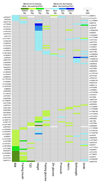Genetic Regulation of Puberty Timing in Humans
- PMID: 25968239
- PMCID: PMC6309186
- DOI: 10.1159/000431023
Genetic Regulation of Puberty Timing in Humans
Abstract
Understanding the regulation of puberty timing has relevance to developmental and human biology and to the pathogenesis of various diseases. Recent large-scale genome-wide association studies on puberty timing and adult height, body mass index (BMI) and central body shape provide evidence for shared biological mechanisms that regulate these traits. There is a substantial genetic overlap between age at menarche in women and BMI, with almost invariable directional consistency with the epidemiological associations between earlier menarche and higher BMI. By contrast, the genetic loci identified for age at menarche are largely distinct from those identified for central body shape, while alleles that confer earlier menarche can be associated with taller or shorter adult height. The findings of population-based studies on age at menarche show increasing relevance for other studies of rare monogenic disorders and enrich our understanding of the mechanisms that regulate the timing of puberty and reproductive function.
© 2015 S. Karger AG, Basel.
Figures



References
-
- Parent AS, et al. The timing of normal puberty and the age limits of sexual precocity: variations around the world, secular trends, and changes after migration. Endocr Rev. 2003;24:668–693. - PubMed
-
- Lakshman R, et al. Early age at menarche associated with cardiovascular disease and mortality. J Clin Endocrinol Metab. 2009;94:4953–60. - PubMed
-
- Morris DH, Jones ME, Schoemaker MJ, Ashworth A, Swerdlow AJ. Secular trends in age at menarche in women in the UK born 1908-93: results from the Breakthrough Generations Study. Paediatr Perinat Epidemiol. 2011;25:394–400. - PubMed
Grants and funding
LinkOut - more resources
Full Text Sources
Other Literature Sources

